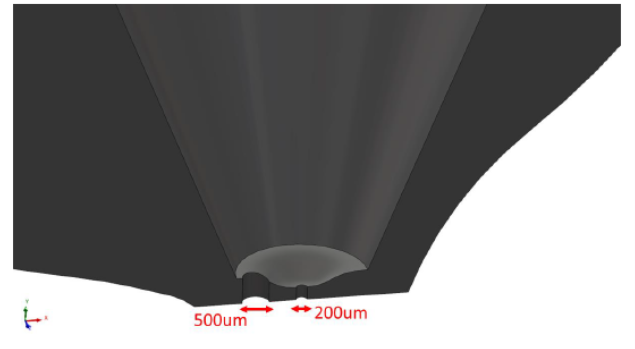For 3D printing of metal components, Drop-on-Demand (DOD) Liquid Metal Jetting (LMJ) offers a less expensive alternative to Laser Powder Bed Fusion (LPBF) additive manufacturing (AM). In DOD-LMJ, a sharp momentum pulse is applied to a volume of molten metal, which induces it to jet through a nozzle; a series of these pulses result in a controlled stream of individual droplets that then rapidly cools and solidifies upon impact with the substrate. For more information about the method, please go to Improved Liquid Droplet Ejection from Gas-Pressurized Printhead.
What would further expand the applications for this technique is a method that allows for controlled jetting of different sized droplets from a single nozzle connected to a liquid metal reservoir. With the flexibility to print at varying resolutions using the same nozzle, components can be fabricated at high deposition rates while still maintaining detailed and complex features.
LLNL’s invention combines four approaches to enable on-the-fly multi-resolution metal droplet printing: (1) a nozzle with two or more orifices of varying diameter and length, (2) a set of corresponding pressure pulses that can eject droplets out of some, but not all, orifices in either magnetohydrodynamic (MHD-LMJ) or Pneumatic-LMJ, (3) the ability to change the pressure pulse on demand, thereby allowing the user to swap between two or more droplet sizes at any time during the printing process, and (4) a computer-controlled motion system and software that digitally represents the 3D printed shape and that maps the appropriate droplet sizes to create lower or higher resolutions and printing modes in the LMJ system.
Image Caption: Cutaway view of a nozzle with 500µm and 200µm diameter orifices next to each other
- Using multi-orifice nozzles provide improved control over droplet ejection in pneumatic Drop-on-Demand 3D printers.
- In-situ resolution selection by matching the pressure pulse selection duration and amplitude to the orifice dimensions.
- The same nozzle is used to print at different resolutions, thereby allowing for both high deposition rates and fine resolution features.
- Drop-on-Demand Additive Manufacturing
- Liquid metal printing
Current stage of technology development: TRL 3
LLNL has filed for patent protection on this invention.


